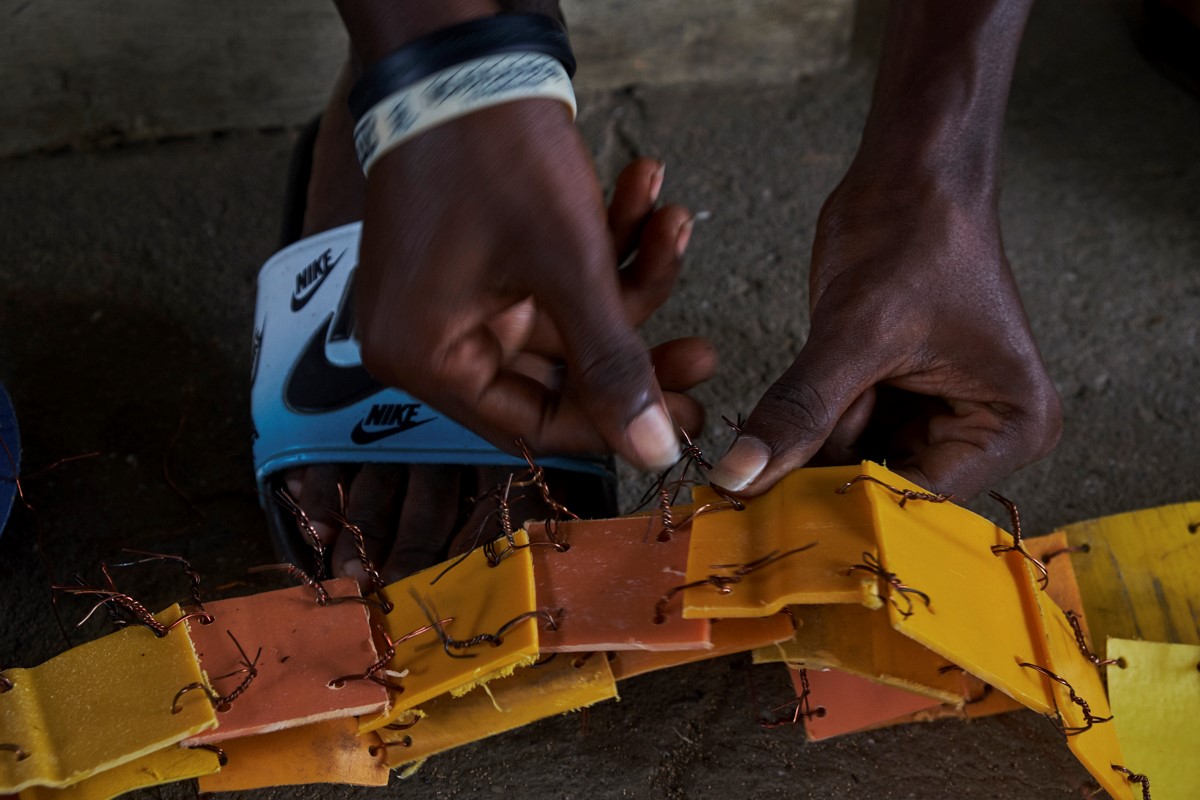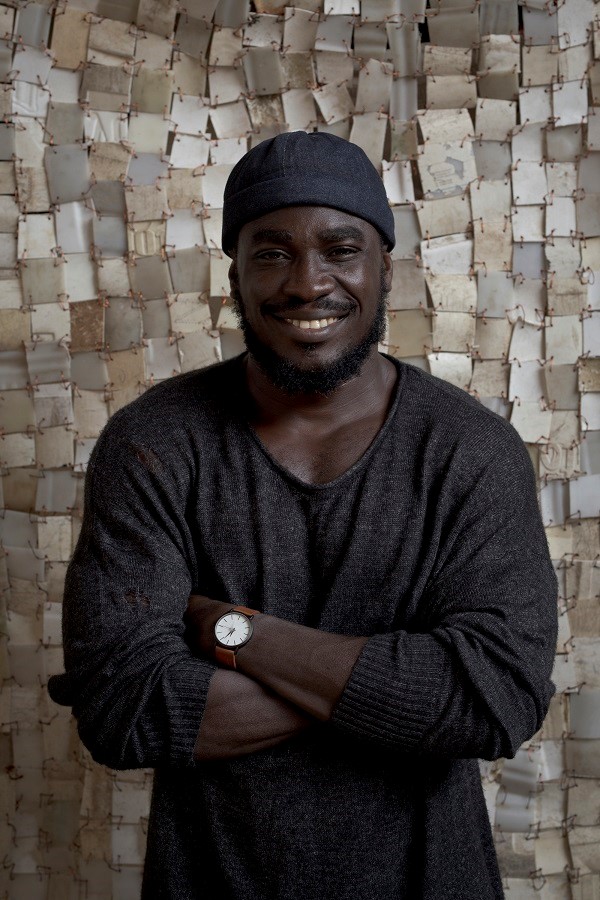Societal ills abound as well as the measures aimed at drawing attention to them and addressing them. For Serge Attukwei Clottey, he is using vivid imagery to stir up conversations about the environment, marginalisation and equity. Considered one of the greatest of his generation, not only for his talent but also for his impact, we take peek at how he is driving change and development with his craft.
Early life and education
Born in Labadi in 1985, Serge perhaps had the genes and the enabling environment to become a great artist. His father was an accomplished artist in his own right and was all too pleased with having his son follow in his steps, contrary to the disdain otherwise displayed by other parents for the arts.
Growing up in his hometown, he was alarmed by the contrast the city’s development presented. On the one hand, there were sprawling high-rise edifices which beautified parts of the city; yet, these are in some part responsible for the filth and inelegance of other parts of the city.
Realising his gift at an early age and impressed by the lasting imprint local art could leave on the mind, young Serge was determined to leave a mark, whilst addressing themes such as social injustice, colonialism, trade and migration.
In the year 2000, he was enrolled at the Ghanatta College of Art and Design (GCAD), Accra, by his father and began exhibiting his works in 2003 with his Different Strokes at the Loom African Gallery in Accra.
In 2006, two years after his time GCAD he gained admission into the Guignard University of Art of Minas Gerais, Brazil on a scholarship; where he was particularly impressed by the heavy influence African culture, particularly that which the coastal people had on art in the country.
Afrogallonism
Yellow jerry cans are everywhere about town. They are seen in the remotest villages as well as corners of all the cities. Originally used in transporting oil, particularly from Europe, they have served as means of transporting and storing water in the country.
These gallons gained notoriety in the early 2000s when sweeping water shortages compelled large number of persons to use the gallons to collect water, especially across long distances. They were duly named Kufuor Gallons, after then-president John Kufuor.
Incorporating these gallons into his craft by cutting, stitching, melting, stacking and wearing them, on the street and as installations, Clottey has given the world Afrogallonsm, which he says addresses environment issues, while also considering the impact of consumerism in the African landscape.
Wishing Well
Sited in the Coachella Valley, the Wishing Well is a sculptural installation of large-scale cubes draped with sheets of woven pieces of the aforementioned Kufuor gallons. The installation has transformed a once bland public park into a destination.
The Wishing Well refers to the wells to which many people around the world must walk daily to access water. As repurposed relics of the colonial project, they serve as a constant reminder of the legacies of empire and of global movements for environmental justice
Whilst not directly alluded to, one cannot help but see similarities between the colour of the gallons and the gold Ghana is blessed with but also the ills of illegal small scale mining (galamsey) and perhaps, even the hue of the water bodies polluted by the act.
360 Art Residency
Whilst the arts have the potential to transform the economy as by serving as alternate asset classes fr investors, a source of non-traditional exports, boost tourism and create employment, t s still largely plagued by the lack of attention from relevant stakeholders, particularly the state.
Reminded of the barriers he had to overcome and very well acquainted with the struggles of young artists in the country, which has only been exacerbated by COVID-19, Serge instituted the 360 Art Residency in the Fall of 2020.
“As an artist I know how it feels to want to create, and be unable to, because of some hardships. I’ve been there before. And that is why I am supporting this initiative. It is my hope that whoever gets the opportunity to attend this residency can create works that speak to their soul,” says Clottey.
The month-long programme saw artists spend time with Clottey and other established creatives, splitting their time exactly between the Attukwei Art House studio at Katamanso, and the second half will be at the Afrogallonism studio in La.

During the time, ideas were shared, bonds forged and resolves made with the cost of accommodation, access to two art studios, and other incentives including transportation, internet connectivity and food, picked up entirely by the host.
Catalogue
Clottey’s extensive catalogue includes participating at the following exhibitions:
“Softening Borders”- The Moody Center for the Arts At Rice University – Houston – USA (2020); “Solo Chorus”- The Mistake Room Los Angeles – USA, “Sometimes in Your Life” – Lorenzelli Arte – Italy (2019); KUBATANA, Vestfossen Kunstlaboratorium, Norway, Fabrica, Brighton, UK (2019).
Brighton University, UK; 360LA, Accra, Ghana; Depart foundation, Malibu, California USA; Defying the Narrative Ever gold Projects, San Francisco, USA; Differences Between Jane Lombard Gallery New York, USA; Gallery 1957 ’’Takeover’’ Lawrie Shabibi, Dubai (2018).
Group Show, Ibid Gallery, Los Angeles; Dans Un Ciel Ensoleille, UTA Artist Space, Los Angeles; Astala Tsala, Patricia Low Contemporary, Gstaad (2017).
My Mother’s Wardrobe, Gallery 1957, Accra; 10th year anniversary exhibition, Nubuke Foundation, Accra; Hand to Mouth, Ever Gold [Projects], San Francisco; Practical Common Sense, Chale Wote Street Art Festival, Jamestown, Accra; Earthly Coversations, GNYP Gallery, Berlin (2016)
We Don’t Contemporary, Kampnagel Hamburg, Germany; What is Matter, Intelligentsia Gallery, Beijing, China; Silence Of An Ordinary Things, The Mistake Room, Los Angeles, California; The Displaced, Feuer/Mesler, New York (2015).
Color Unfinished, 27th Festival Les Instants Vidéo, Marseille; Migration Messages, Collective Realities of African Migration, WUK, Vienna; Global Art Local View, European Monument Day, Mohr Villa, Munich; MULTIPOINT International art Symposium, Nitra; The Auction Room — African Contemporary Photography, Ozwald Boateng, London; Masked Unmasked, 11th Dakart, Dakar; Du Bois In Our Time II ‘Colour Unfinished’, University of Amherst, Massachusetts and Nubuke Foundation (2014).

Muses, Goethe Institute, Accra; Art Speaks, Residency at Wuk, Vienna; Du Bois in our Time I ‘Colour Unfinished’, University of Amherst, Massachusetts and Nubuke Foundation; Insidethemoskitonet, Alliance Française, Accra; We Are Africa, Nubuke Foundation, Accra2013
whose puppet are you?, performance, Accra; Time, Trade & Travel, Stedelijk Museum Bureau, Amsterdam and Nubuke Foundation, Accra; The Beautiful ones are not yet born, Goethe Institut, Accra; Alternative Independence Day Celebration, Freedom Tour, Nubuke Foundation, Accra, Ghana; Inside The Mosquito Net, Brazil House Jamestown, Accra (2012)
Cultures in Confluence, Alliance Française & Goethe Institut, Accra; Trash to Treasure, chale wote street art festival, Accra (2011). Climate Change, Caspar House, Accra; Portrait of Ghana, The Drum Ace Café, Birmingham, UK; My Life, Charity Photo Show, W.E.B. Dubois Memorial Centre, Accra and Haverford College, Pennsylvania (2010).
Africa Show, African Contemporary Art, Naples (2009); Global Warming, Featured Project, British Council, Accra; Portrait of Accra, Junior Art Club sponsorship, Bristol (2008); Untying the Human Spirit, CAN 2008, Goethe Institute, Accra (2008) and Different Strokes, The Loom African Gallery, Accra (2003). With collections at Modern Forms, UK; Nubuke Foundation, Accra; Seth Dei Foundation, Accra as well as the World Bank Collection, Washington D.C.










